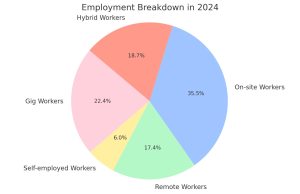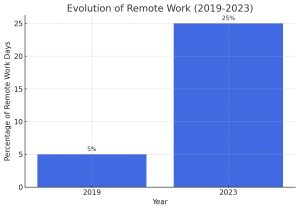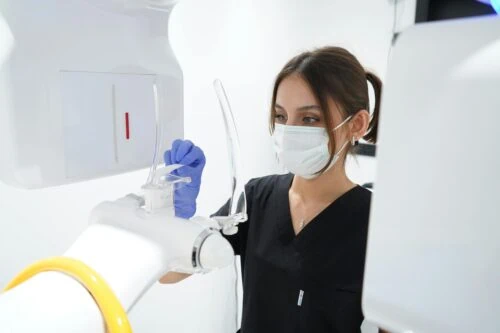The workplace concept has seen major changes in recent years, mirroring wider societal and technological changes. This ultimate guide to the workplace explores these evolving dynamics, offering insights into how workplaces adapt to meet new challenges and diverse opportunities. From the rise of remote work to the integration of AI and automation, we’ll delve into the factors reshaping our work environments and the implications for employees and organizations.
The Workplace
The concept of the ‘workplace’ has transformed dramatically in today’s job market, far beyond the traditional four walls of an office. With a staggering 16% of companies globally being fully remote and over 40% of the American workforce engaged in remote work, the essence of what constitutes a workplace is in flux. This shift is the result of technological advancements and societal changes, reflecting evolving human aspirations.
What is a Workplace?
At its core, a workplace is any location where work is performed. Historically, this was a physical space like an office for accountants, a factory for machine engineers, or a shop floor for sales professionals. However, the definition has broadened to include remote setups, where employees work from various locations using digital tools, and hybrid models, which blend in-office and remote work. Furthermore, the gig economy has introduced a more fluid version of the workplace, often characterized by short-term contracts or freelance work, shifting the traditional workplace boundaries even further.
The Evolution of the Workplace
The workplace has undergone several significant transformations throughout history. The 18th and 19th centuries Industrial Revolution marked a substantial shift from farmlands to manufacturing factories, fundamentally changing the nature of work and worker relationships. In the 20th century, they introduced the concept of office, particularly in the post-World War II era, as white-collar jobs became more prevalent. The digital age has defined the late 20th and early 21st centuries, which has revolutionized workplaces with technology, leading to more knowledge-based work and a significant increase in remote and flexible working arrangements.
Why the Workplace Matters
Workplaces are more than just locations for labor; they are pivotal to individual well-being, organizational success, and societal development. A well-designed and positive workplace can enhance productivity, improve employee satisfaction, and promote creativity. The workplace is often a source of identity and social interaction for individuals. On an organizational level, the workplace environment directly impacts performance and innovation. Societally, workplaces influence economic trends, shape cultures, and affect community development.
Current Landscape
The current state of workplaces globally is characterized by several key trends. Remote work has become a staple, with many employees expecting flexible working arrangements. Automation and artificial intelligence are reshaping job roles and responsibilities, requiring new skills and approaches to work. Demographic changes influence workplace dynamics, including aging populations in some regions and increasing workforce diversity. Environmental and sustainability concerns are also becoming integral to workplace strategies, reflecting a growing awareness of the broader impact of organizational operations.
Key Drivers of Change in the Workplace
The constant evolution of the workplace and its diverse people is driven by several key factors reshaping how, where, and why we work. These drivers of change influence current workplace diversity trends and set the stage for the future of work.
Technological Advancements
The impact of technological advancements on the workplace is profound and multi-dimensional. Artificial Intelligence (AI) and automation are at the forefront, transforming job roles and processes. AI is increasingly used for data analysis, customer service roles through chatbots and decision-making. Automation is reshaping industries by performing repetitive tasks more efficiently than humans. About 30% of tasks in 60% of occupations could be automated, demonstrating the significant impact of this technology on the future of jobs. As automation and AI become increasingly integrated into the workplace, human interaction is becoming more important to connect with diverse groups.
Additionally, communication tools have revolutionized the way we collaborate. The rise of platforms like Zoom, Slack, and Microsoft Teams has made remote and hybrid work models feasible and practical. Cloud computing allows for flexibility in data access and collaboration from anywhere in the world. These technological innovations have made workplaces more efficient, adaptive, and boundaryless.
Demographic Changes
Demographic shifts significantly influence workplace dynamics. Aging populations in many developed countries are leading to changes in work policies, focusing on retaining older workers and transferring their knowledge. By 2030, the U.S. Bureau of Labor Statistics predicts that 30% of the American workforce will be 55 or older. Conversely, there’s a push for more innovative and tech-savvy work environments in regions with a younger demographic.
Changing family structures and cultural shifts also play a crucial role. There’s an increasing demand for family-friendly workplace policies, flexible working hours, and work-life balance support, reflecting today’s workforce’s diverse needs. In addition, the growing cultural diversity within the workforce is prompting organizations to create more inclusive and accommodating work environments.
Environmental Concerns
Sustainability is becoming a central concern for businesses worldwide. This focus is driving changes in office design, emphasizing eco-friendly materials, energy efficiency, and waste reduction. Companies are also reevaluating business travel policies, promoting virtual meetings, and encouraging sustainable commuting options to reduce their carbon footprint. A study by Global Workplace Analytics suggests that if those with remote-compatible jobs worked remotely half of the time, the reduction in greenhouse gases would be equivalent to taking the entire New York State workforce off the road.
Resource usage in the workplace is undergoing scrutiny as well. There’s a growing trend toward using renewable energy sources and implementing green policies like recycling and digital documentation to minimize paper use. These changes are not only environmentally responsible but are also often cost-effective in the long run.
Employee Expectations
Modern employees are looking for more than just a paycheck. They seek a sense of purpose and fulfillment from their work. This shift in expectation has led companies to focus more on their cultural and social impact, aligning their values with those of their employees.
Work-life balance is another critical area of employee expectations. Workers increasingly value flexibility in their schedules and the ability to work remotely. This desire for balance drives changes in workplace policies and practices, making flexible hours and remote work options more commonplace. Recent studies show that 87% of millennials consider professional development and career growth opportunities ‘very important’ when considering a job.
Moreover, personal growth and career development are high on the list of employee priorities. As a result, there’s a growing emphasis on continuous learning, skill development, and career progression opportunities within the workplace.
Different Forms of the Modern Workplace
The workplace has diversified significantly in recent years, adapting to technological advances, cultural shifts, and changing employee expectations. This evolution has led to the emergence of various forms of workplaces. The modern workplace is not a one-size-fits-all concept but a spectrum of multiple models, each with advantages and challenges.

The Traditional Office
Despite the rise of remote work, the traditional office remains relevant. Physical workplaces offer distinct benefits such as easier collaboration, direct supervision, and immediate social interaction. They foster employees’ sense of community and belonging, enhancing team spirit and corporate culture. Additionally, for specific industries and roles, the physical presence in an office is indispensable for effective operation. However, the traditional office model also evolves, emphasizing flexible workspaces and employee well-being.
The Remote Revolution
The shift towards remote work has been one of the most significant workplace transformations in recent years. This model offers numerous advantages, including increased employee flexibility, business cost savings, reduced need for physical office space, and access to a broader talent pool unrestricted by geographical boundaries. However, remote work also presents challenges, such as potential feelings of isolation, difficulties in communication and collaboration, and the blurring of work-life boundaries. Companies are increasingly seeking solutions to these challenges to make remote work more sustainable and effective.
Hybrid Models
Hybrid work arrangements, which combine elements of both traditional and remote workplaces, are gaining popularity. These models provide a balance, offering the flexibility of remote work while retaining the benefits of in-person interactions. Successful implementation of hybrid models requires careful planning and consideration, such as defining which roles are suitable for remote work, ensuring fair treatment of all employees regardless of their location, and investing in technology that supports collaboration across different settings.
The Gig Economy
The gig economy, characterized by short-term contracts or freelance work instead of permanent jobs, has been increasing. It offers opportunities for workers to enjoy more flexibility, autonomy, and the possibility of higher earnings, especially for skilled professionals. For businesses, it allows for cost-effective scaling of labor according to demand. However, this model also poses challenges, such as a lack of job security and benefits for workers and potential quality and consistency issues for businesses.
The Future of Work
Looking ahead, the future of the workplace may include even more diverse and innovative models. Co-working spaces are becoming popular, especially among freelancers and small businesses, providing a sense of community and shared resources. Virtual reality (VR) and augmented reality (AR) technologies are being explored for remote training and immersive work experiences. Furthermore, artificial intelligence (AI) is expected to significantly automate routine tasks, aid decision-making, and even manage remote teams. As these technologies evolve, they will likely create new opportunities and challenges for workers and businesses.
Impact on Employees and Organizations
As the workplace evolves, it has significant effects on employees and organizations. These changes bring a mix of benefits and challenges that are reshaping the diverse modern work environment.
Benefits for Employees
The changing workplace has several positive impacts on employee well-being, productivity, and job satisfaction:
- Increased Flexibility: Remote and hybrid work models offer employees greater flexibility in managing their work schedules, which can lead to improved work-life balance.
- Reduced Commute Stress: Working remotely eliminates commuting, saves time, and reduces stress, contributing to overall well-being.
- Autonomy and Empowerment: New work models often empower employees with more control over their work environment and methods, increasing job satisfaction.
- Diverse Opportunities: The gig economy and temporary work models provide access to a broader range of job opportunities, not limited by geographic location.
- Personalized Work Environments: The ability to work in a customized space can increase comfort and, potentially, productivity.
Challenges for Employees
However, these new work models also present potential downsides:
- Loneliness and Isolation: Remote work can lead to loneliness and isolation, as employees miss out on social interactions in traditional office settings.
- Burnout: Blurring boundaries between work and personal life can lead to longer working hours and increased risk of burnout.
- Work-Life Balance Struggles: Managing work-life balance can be challenging, especially for those working from home, where domestic responsibilities overlap with work duties.
- Career Development Concerns: In remote settings, employees might worry about reduced visibility affecting their career progression opportunities.

Benefits for Organizations
Adapting to new work models can offer several advantages to businesses:
- Broader Talent Pool: Remote and hybrid work allows organizations to access a global talent pool to find the best candidates regardless of location.
- Cost Efficiency: Reductions in office space and related overhead costs can lead to significant savings for organizations.
- Innovation Boost: Diverse work models can foster a culture of innovation, as employees bring varied perspectives and ideas.
- Increased Employee Retention: Flexible work arrangements and increased work-life balance increase employee satisfaction and retention rates.
Challenges for Organizations
Conversely, these new models pose particular challenges for businesses:
- Managing Remote Teams: Ensuring effective communication, collaboration, and productivity in remote teams requires new management skills and tools.
- Building Company Culture: Maintaining a strong company culture is more challenging when employees are dispersed and have fewer opportunities for in-person interactions.
- Maintaining Productivity: Ensuring consistent productivity levels, particularly in remote or hybrid settings, can be challenging, requiring robust performance tracking systems.
- Security Concerns: Remote work can increase cybersecurity risks, necessitating improved security protocols and employee training.
The new workplace landscape presents a complex array of benefits and challenges for both employees and organizations. Navigating these effectively requires adaptability, innovative management practices, and a commitment to supporting the needs and well-being of the workforce. As the workplace evolves, balancing these factors will be a key to success in the modern business landscape.
Best Practices for Adapting to the Changing Workplace
Adapting to the rapidly evolving workplace landscape requires a strategic approach, encompassing everything from fostering a positive culture to leveraging technology effectively. Here are some of the best practices to help individuals and organizations navigate these changes successfully.
Building a Positive Workplace Culture
Creating a positive workplace culture is crucial in any work model:
- Encourage Open Communication: Focus on regular and open communication across all levels of the organization. Utilize various communication tools to ensure everyone feels heard and involved, whether in-office or remote.
- Promote Collaboration: Use collaborative tools and platforms that facilitate teamwork. Regular team meetings and virtual brainstorming sessions can help maintain a cooperative spirit.
- Cultivate Inclusivity: Create policies and practices that support diversity and inclusivity. This includes being mindful of different time zones, cultural backgrounds, and work-life circumstances in a diverse global workforce.
- Recognize and Reward: Implement systems to regularly acknowledge and reward employees’ efforts and achievements, boosting morale and fostering a sense of belonging.
Supporting Employee Well-being
Employee well-being is more important than ever:
- Encourage Work-Life Balance: Advocate for precise work and personal life boundaries, especially for remote workers. Encourage employees to take regular breaks and utilize their leave.
- Offer Support Resources: Provide access to mental health resources, such as counseling services or wellness programs.
- Ergonomic Work Environments: Educate employees on setting up an ergonomic home office to prevent physical strain.
- Promote Physical Activity: Encourage regular physical activity through company-wide challenges, virtual fitness classes, or health club memberships.
Embracing Technology Effectively
Effective use of technology is critical to adapting to the changing workplace:
- Choose the Right Tools: Select technology tools that best fit the specific needs of your team, whether for project management, communication, or collaboration.
- Training and Support: Provide training for employees on how to use new technologies effectively. Continuous technical support is also essential.
- Cybersecurity Awareness: With the increase in remote work, prioritize training employees on cybersecurity best practices.
- Balance Tech and Personal Interaction: While technology is crucial, maintaining personal connections is also critical. Regular video calls or occasional in-person meetings can help keep these connections.
Developing Future-Ready Skills
Preparing for the future workplace involves continuous learning and skill development:
- Encourage Continuous Learning: Create a culture of learning within the organization. Offer opportunities for professional development through courses, workshops, and webinars.
- Focus on Soft Skills: Along with technical skills, emphasize the importance of soft skills like adaptability, communication, and problem-solving, which are crucial in a changing work environment.
- Stay Informed on Trends: Encourage employees to stay updated on industry trends and emerging technologies that could impact their work.
- Leadership Development: Invest in developing future leaders adept at managing diverse and dispersed teams.
FAQs
What constitutes a modern workplace?
A modern workplace can be traditional, remote, hybrid, or part of the gig economy, utilizing digital tools and flexible work arrangements to adapt to technological and societal changes.
How are technological advancements affecting workplaces?
Technologies like AI, automation, and various communication tools are transforming job roles, enhancing remote collaboration, and making workplaces more efficient and adaptable.
What are the main challenges of remote work?
The main challenges include potential feelings of isolation, difficulties in maintaining work-life boundaries, and ensuring effective communication and collaboration among dispersed teams.
Why is workplace culture important in modern work environments?
A positive workplace culture enhances employee satisfaction, fosters collaboration, and supports diversity and inclusivity, which are crucial for organizational success in diverse work settings.
What strategies can organizations adopt to support employee well-being?
Organizations can promote work-life balance, provide ergonomic work setups, offer mental health resources, and encourage physical activity to ensure the well-being of employees.
Conclusion
The workplace is transforming, reshaped by technological advancements, demographic shifts, environmental concerns, and evolving employee expectations. We’ve explored the diverse forms of modern workplaces, from traditional offices to remote and hybrid models and the burgeoning gig economy. While these changes present opportunities and challenges for employees and organizations, they also offer a path toward greater flexibility, innovation, and inclusivity. Looking forward, the future of work holds immense growth and adaptability potential as we continue to navigate and harness these evolving dynamics. Join Diversity Employment today, upload your resume, and find your dream job with an equal opportunity employer today!




